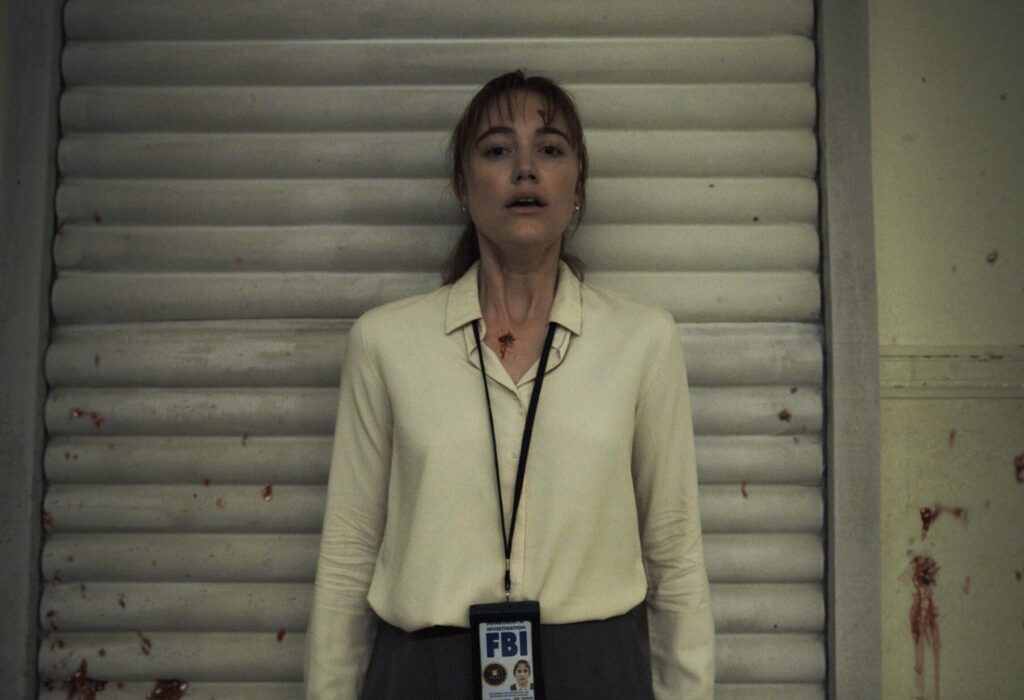“Longlegs” Is Slow Burn Horror At It’s Finest

No one does atmospheric horror like Oz Perkins. The visionary director of Gretel & Hansel, The Blackcoat’s Daughter, and I Am the Pretty Thing That Lives in the House excels at slow burn terror and omnipresent dread. In film after film, he pulls the viewer into a nightmarish world often representative of his own traumatic past. With glacial pacing and exquisite composition Perkins challenges us to sit with the darkness and watch as unspeakable creatures emerge from all sides. This talent for destabilization is on full display in Longlegs – a pitch black story filled with icy dread. As agent Lee Harker (Maika Monroe) hunts for a satanic killer known only as Longlegs (Nicolas Cage), Perkins uses eerie imagery and distressing sound to burrow steadily under the skin.
The film opens on a snowy scene as a nondescript station wagon approaches a rural house. An overtly friendly man dressed in winter white approaches a young girl on the eve of her birthday. Perkins draws out this revelation with creative framing and rapid cuts, bombarding us with images of the killer’s grisly crimes before revealing the totality of his unnerving face. It’s a curious creature design that may prove polarizing, but this pale-faced persona perfectly blends in with the icy background. Cage’s unsettling demeanor and high pitched, almost lilting voice destabilizes us with nods to the uncanny valley. At first blush, Longlegs feels more like a kooky neighbor we’d be tempted to pity than the ruthless killer he will turn out to be. Cage dances on the line of silly and sadistic and we’re never quite sure if we should laugh or scream. Though some will dismiss this powerhouse performance as over-the-top nonsense, the cheerfully evil Longlegs will likely be haunting the dreams of many viewers well after the final credits roll.
Monroe brings her trademark fragility to the solitary Harker, a withdrawn FBI agent who may possess a hint of telepathy. After long days investigating the worst of humanity, this freshman agent prefers to spend most of her time alone. Alicia Witt plays her unstable mother Ruth and their strained relationship adds another element of vulnerability to an already disquieting film. We don’t learn many details of their troubled past, but it feels like both women are struggling to connect across an ocean of secrets. These subdued roles could easily come off as wooden or shallow in the wrong hands, but both actresses add just enough endearing instability to keep us invested in the fractured family.
Supervising Harker on this upsetting case is Agent Carter (Blair Underwood), the only source of comfort in an exceedingly bleak film. The genial family man is the audience’s conduit and guides us through upsetting details of taboo crimes. Underwood grounds the film and reminds us that there is still something to fight for in this dreary world. A late shift in his demeanor proves to be one of the film’s most startling moments and makes us long for the veteran actor to do more horror. Kiernan Shipka makes a brief appearance as the killer’s sole survivor. Though she ultimately doesn’t contribute much to the story, the upsetting scene shows the wreckage left in Longlegs’ wake and raises the stakes for future crimes.
Though Perkins has perfected the art of slow burn horror, he’s not really known for holding back. Longlegs centers on pure satanic evil with little motive offered for these unthinkable crimes. From the opening sequence, we’re bombarded with overwhelming dread and terror emerging from idyllic snowy days. With his trademark slow pacing and intentional pans, Perkins lingers on empty doorways and darkened rooms, daring us to wonder what may be lurking there just out of sight.
Set during the Clinton administration, we feel the lack of technology and the isolation of the analog era. Harker’s investigation is done with pen and paper and we’re treated to a microfiche montage laying out each hideous crime. The film wears it’s homage to The Silence of the Lambs on its sleeve, but aside from the procedural format and dingy vibe, Longlegs is something else altogether. The muted palette perfectly balances the heat of Longlegs’ sinister obsession and creates a shocking explosion of violence and gore when the full scope of his plans finally take shape. Despite visual connections to Gretel & Hansel, Longlegs feels most indebted to Perkins’ debut film, The Blackcoat’s Daughter – another icy story that concludes with shocking acts of satanic violence.
Like the rest of his oeuvre, Longlegs is simultaneously gorgeous and terrifying. This drab world is filled with fascinating intricacies from the bizarre construction of Harker’s house to the cold uniformity of a suburban street. One particular sequence follows the two detectives as they investigate an abandoned barn while a stunning storm rolls in at dusk. They wander through the former crime scene with only their flashlights to show the way. With scant relief to be found, it’s nearly impossible to look away and each new sequence feels like walking into a visual trap.
Longlegs is the kind of film that builds over time. Many will walk out of the theater feeling confused only to find their minds returning to the story again and again. It’s a collection of unnerving imagery and omnipresent dread that proves to be greater than the sum of its parts. The deliberate pacing and less-is-more approach will not be for everyone and Perkins intentionally leaves some questions unanswered. But for those craving bleak nihilism building to bloody devastating, Longlegs succeeds more than any film in recent memory.
Jenn Adams is a writer, podcaster, and film critic from Nashville, TN. Find her social media nonsense @jennferatu.